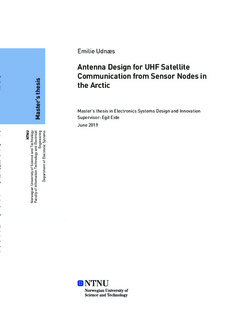| dc.contributor.advisor | Egil Eide | |
| dc.contributor.author | Emilie Udnæs | |
| dc.date.accessioned | 2019-10-26T14:04:14Z | |
| dc.date.available | 2019-10-26T14:04:14Z | |
| dc.date.issued | 2019 | |
| dc.identifier.uri | http://hdl.handle.net/11250/2624673 | |
| dc.description.abstract | Målet med denne avhandlingen har vært å vurdere om en praktisk antenne kan designes og implementeres til innsamling av 2-200GB data i løpet av et år, fra sensornoder i Arktis. Dataen vil sendes via småsatellitt på Ultra Høy Frekvens. To spesifikke brukstilfeller definerer designbegrensningene. Første brukstilfelle er HYPSO (HYPer-spectral Smallsat for ocean Observation), en småsatellitt NTNU skal skyte opp i en lav jordbane i 2020. Satelitten har en programvare-definert radio som sekundær nyttelast. Den skal sørge for bedre kommunikasjonsmuligheter i Arktis. Det andre brukstilfelle er Arctic ABC, et forskningsprogram som utvikler sensornoder i Arktis som genererer store menger data. Ulike antennetyper ble vurdert med tanke på at de burde veie mindre enn 50kg, være mindre enn 1×1×1m3 i størrelse, være låst mekanisk (dvs. mekanisk styring er ikke mulig) og ha en antennevinning på 2-10dBi. Det ble konkludert at en antennegruppe på fire invertert-F antenner med et matningssystem slik at det genererer sirkulær polarisasjon, har potensialet til å oppfylle kravene i prosjektet. Antennen ble designet for 400MHz, og resultatene av simuleringene viser at den har en maksimal realisert antennevinning på 4dBi i retning av en satellitt som kommer til syne 45 grader over horisonten. Strålingsdiagrammet har en konisk form med et lavpunkt i senit hvor antennevinningen reduseres til -3dBi. Basert på link-budsjettet og simuleringsresultatene ble det konkludert at totalt ∼10GB/år med data kan hentes ut fra sensornoder nord for Longyearbyen, ved hjelp av HYPSO. Grunnet ionosfærisk aktivitet i atmosfæren, samt andre tapsfaktorer, kan datautbyttet imidlertid forventes å være et sted mellom 2GB og 11GB. En prototype av antennen ble produsert og testet ved hjelp av utstyr tilgjengelig på NTNU. Testresultatene viser at strålingsdiagrammet ikke svarer til simuleringene slik som forventet. Fremtidig arbeid for å teste antennevinning, temperaturtoleranse og polariseringsegenskaper av antenneprototypen er foreslått for å validere om antennen er egnet for implementering i Arktis. | |
| dc.description.abstract | The objective of this thesis has been to evaluate whether a feasible and practical antenna can be designed and implemented for the retrieval of 2-200GB/year of data from sensor nodes in the Arctic, using small satellites at Ultra High Frequency. Two use cases were selected to define the design constraints. The first use case is HYPSO (HYPer-spectral Smallsat for ocean Observation), the small satellite that NTNU will be launching in 2020 into a Low Earth Orbit. Its secondary payload is a Software Defined Radio that aims to provide better communication systems in the Arctic. The second use case is Arctic ABC, a research program that develops sensor nodes in the Arctic generating large amounts of data. Different antenna types were evaluated considering that they should weigh less than 50kg, be less than 1×1×1m3 in size, stay mechanically fixed (i.e. antenna pointing mechanism is not possible) and have a gain of 2-10dBi. It was concluded that an array of four Inverted-F Antennas with a feed system such that it generates circular polarization, has the potential to fulfill the requirements of the project. The antenna array was designed for 400MHz and the results of the simulations show that the antenna has a maximum realized gain of 4dBi in the direction of a satellite appearing 45 degrees above the horizon. The radiation pattern has a conical shape with a dip in zenith where the gain decreases to -3dBi. Based on the link budget and the results of the simulations, it was concluded that in a year, a total of ∼10GB of data can be collected from sensor nodes located north of Longyearbyen, using HYPSO. However, because of ionospheric activity in the atmosphere as well as other loss factors, the data throughput can be expected to be between 2GB and 11GB. A prototype of the antenna was fabricated and tested using facilities and equipment available at NTNU. The test results show that the radiation pattern is not as similar to the simulations as expected. Future work to test the gain, temperature tolerance and polarization characteristics of the antenna prototype is suggested in order to validate whether the antenna is suitable for implementation in the Arctic. | |
| dc.language | eng | |
| dc.publisher | NTNU | |
| dc.title | Antenna Design for UHF Satellite Communication from Sensor Nodes in the Arctic | |
| dc.type | Master thesis | |
